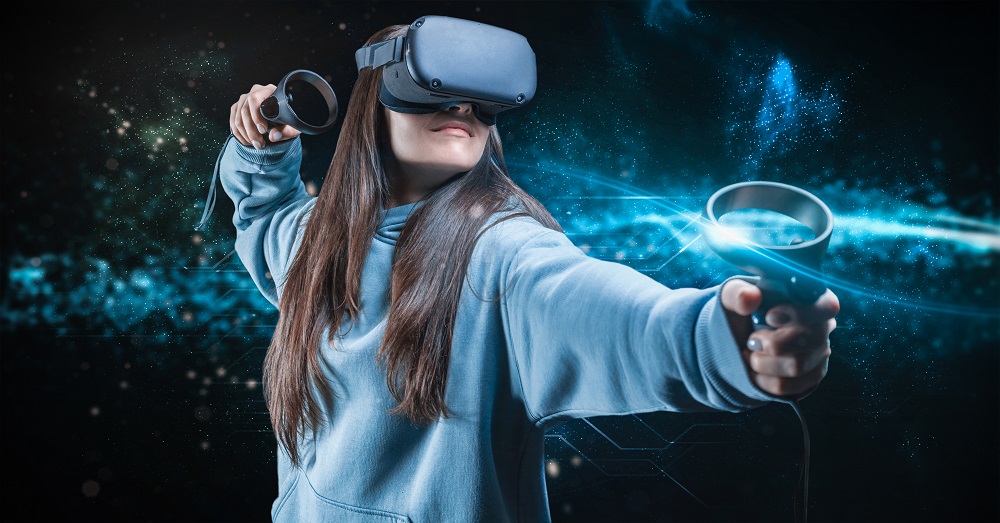The Future of Virtual Reality in Gaming: Exploring the Immersive World
The concept of Virtual Reality, as we know it today, is not a new phenomenon. In fact, it has been brewing for several decades. There are many pioneering moments in digital history that have seen both crude and successful attempts, but majorly, it was in the 1990s when it actually gained traction.
Companies like Sega and Nintendo introduced gaming devices that hinted at a future of VR in gaming. These were, effectively, baby steps in the world of VR, but though limited in technology, video games and attempts such as these essentially laid the foundation for future advancements.
What really propelled VR in the tech industry was when consumer-grade VR headsets became more prominent and readily available in the market.
Following the acquisition of Oculus by Meta (then Facebook), the mid-2010s saw the launch of headsets such as Quest, HTC Vive, and even PlayStation VR. These devices had improved tracking and graphical fidelity, offering a more appealing experience to users.
Aside from VR in gaming, industries such as healthcare, architecture, and education, among others, began to adopt the technology for various applications within their sectors.
But with an estimated 70% of sales of VR headsets going towards gaming and entertainment audiences, it’s safe to say that the future of VR in gaming holds a lot of potential for the entertainment industry and business leaders.
What’s the Impact of VR Gaming on the Rise of VR?
As we’ve seen in gaming trends over the years, the relationship between gaming and virtual reality runs deep.
Typically, it’s gaming that benefits profoundly from hardware advances, but with VR in the gaming industry, video games have had a sort of a symbiotic relation where both gaming and VR have benefitted, almost in equal parts.
Let’s take a look at how gaming has had an influence on the growth of VR:
1. Mainstream Appeal:
The industry for video games is massive and one that is most eager to adopt new technologies, whether it be consoles, computer software, and hardware upgrades.
They are also one of the most tech-savvy audiences and have, thus, quite eagerly embraced virtual reality gaming into the fold. This enthusiasm amongst gamers and the growing interest in the industry has led to greater adoption rates of VR in gaming and beyond.
2. Investment and Funding:
Similar to blockchain for gaming, a major attraction for many businesses and enterprises now entering the fray of video games is the ability of the gaming industry to generate tons of revenue consistently.
- With the market size for VR in gaming expected to reach $54 billion by 2028 (Fortune Business Insights), it comes as no surprise that tech giants and venture capitalists are investing in the future of VR gaming.
In addition to increasing the avenues for growth, this also accelerates the development of VR technology as we know it today.
3. Esports and Virtual Interactions
At the end of 2022, the eSports audience size was reportedly 532 million (Statista). By 2025, this number is predicted to reach 650 million worldwide, with Asia and North America emerging as the most significant growth markets.
Despite being relatively new to eSports, the use of VR gaming has gradually increased in this sector, with the revenue for virtual gaming content poised to hit $7 billion by 2025.
Additionally, VR enhances the social interactions and multiplayer aspect of games by allowing players to meet and communicate in virtual worlds, increasing the appeal of VR and top AR games in the community.
4. Crossovers with Other Industries
The advancements and adoption rates of VR in gaming have also positively impacted other industries. As of 2023, the total market size for VR rests at $15.8 billion and will soon cross $22 billion by 2025.
Gamification in the workplace and for schools has led to the adoption of VR in areas such as education, office spaces, and training. Developers have begun using the lessons learned from gaming to enable innovative applications in fields such as healthcare, construction, and others which benefits both gaming and non-gaming VR experiences.
These are some of the significant ways which describe the impact of VR gaming on virtual reality, the tech, and the market for it. The video game industry constantly strives for immersive experiences, improved storytelling and gameplay experiences, tech advancements, and unique content – which has led to the widespread adoption of VR amongst gaming audiences.
And we can see that gaming’s influence on virtual reality has been substantial.
New Developments Shaping Virtual Reality Gaming Experiences
VR in gaming has seen some exciting upgrades in recent years. There are new innovations and trends, some of which might just end up giving us the best metaverse games of this decade.
Now, the global user penetration rate of VR hardware and headsets might be low compared to that of traditional video games, standing at 45%, but those numbers are just set to change and grow with developments such as:
1. Hardware Improvements:
As the world of tech keeps soldiering on, so does the hardware required to support and enable VR. The gaming hardware for VR has become more powerful, compact, and comfortable over the years.
Moreover, the release of powerful headsets, such as Apple Vision Pro and Meta’s upcoming Quest 3, is an assuring sign of more advancements to come in terms of display technology, resolution, visuals, and spatial stability.
2. Haptic Feedback:
Haptic feedback systems have already surfaced in controllers for gaming consoles, but the gaming industry is now seeing the use of advanced haptic tools such as gloves and suits – designed to provide a realistic sense of touch and other tactile sensations.
For instance, Ubisoft, in partnership with OWO, has created a haptic suit that, through a series of gel pads, feedback instruments, and electrodes, is designed to help users feel what they play. This would be pivotal for their future release titled ‘Assassin’s Creed Nexus,’ which would be a VR-only title.
3. Body Tracking and Gestures:
In addition to haptic feedback, future VR systems are being primed to offer improved body-tracking features.
These upgrades will allow players to interact with game environments using any part of their body and limb instead of just their hands – leading to more intuitive gameplay mechanics where the immersive elements feel more natural and organic for gamers.
4. Integration of AI:
Nearly all elements that a player sees in their game are programmed and conditioned to behave in a set way when they interact with them. This includes the objects, NPCs, story options, etc. Integrating artificial intelligence (AI) and procedural generation can ensure dynamic and more engaging experiences for VR in gaming.
It might be paired with tools such as Unity 3D game development to enable a VR game to generate vast and unique environments, interactions with new objects, and more.
It’s important to note here that while these are some really exciting possibilities for VR in gaming, the trajectory it takes will depend on not just the advancements but also the demand for it in the market and overall industry trends.
Nonetheless, we are already seeing examples of such developments in the space for virtual reality gaming, and it is likely that even more will emerge, pushing the boundaries as ever.
How is VR Used in Gaming? Notable Examples:
Though the gaming industry isn’t new to VR titles and has, as we’ve seen, been one of the early adopters of this emerging technology, there have been certain VR games that have taken the community by storm.
There’s no mastering game marketing to achieve what these titles have done, as they have captivated gamers from all over with their immersive and unique gameplay experiences. Such as:
1. “Half-Life: Alyx” by Valve Corporation
Released back in 2020, Half-Life Alyx by Valve is a highly acclaimed VR title set in the Half-Life universe that fans have come to know and love.
It opened up thousands of gamers and loyal users to the innovative uses of VR through its mechanics, coupled with some immersive storytelling moments and compelling bits of gaming.
This was one of the first games that demonstrated how VR in gaming could be used for even AAA-quality games and not just small, indie titles.
2. “Superhot VR” by SUPERHOT Team.
There’s a non-VR version of this game, which initially made this title extremely popular, but the VR version came with a slew of new features that utilized the VR headsets’ range of capabilities. It had a unique, time-based combat system where time moved only when the player moved.
The shootouts made for some intense moments, and the gameplay, coupled with smart visuals and strategies, helped it stand out in the gaming landscape.
3. “Beat Saber” by Beat Games.
Beat Saber is among the most popular and viral sensations in gaming and entertainment. So much so that even if you haven’t played the game, there’s a good chance you’ve seen it on your social media feeds.
It allows players to hold virtual ‘lightsabers’ and use them to ‘slash’ through blocks depicting specific directions in sync with the beat. It’s often praised for popularizing VR-based music games and show to gamers how active and immersive the gameplay can get for them.
4. “Resident Evil 7: Biohazard” by Capcom.
Resident Evil’s first-person survival horror game was already a big hit amongst gamers, owing to the atmosphere and visuals that were made not with unreal engine game development but through their proprietary RE Engine.
Integrating VR into the game only further heightened the sense of fear and dread that captivated fans of the series as it increased immersion and allowed gamers to experience the suspenseful gameplay in a new manner.
Embrace the Future of VR Gaming
These are some famous and notable titles in the industry that have embraced VR in gaming. As the technology continues to grow, there’s no doubt that virtual reality games are poised to become mainstream in the coming years, as the captivating world and immersive settings of VR offer a level of engagement that’s unparalleled in all other gaming mediums.
As we move forward, it is clear that developers and gamers have already begun to embrace the VR phenomenon in video games – especially since game development companies and entrepreneurs have quite a few reasons to be optimistic about the future of virtual reality in gaming.
However, developing a VR-ready gaming title comes with its own set of challenges. And you would need the help of a passionate team that will turn these challenges into opportunities instead.
"Join us at EDIIIE, and let’s unlock its full potential in redefining how we play and make games"








